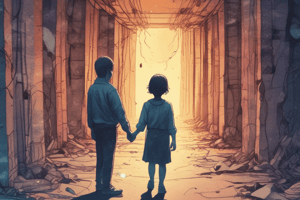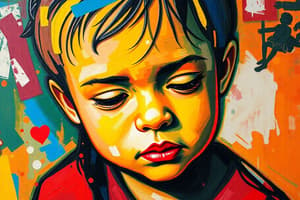Podcast
Questions and Answers
What is a key consequence of physical abuse of a child?
What is a key consequence of physical abuse of a child?
- Emotional scarring
- Death (correct)
- Physical strength gain
- Financial instability
What is an example of emotional abuse?
What is an example of emotional abuse?
- Encouraging a child to play
- Hugging a child
- Restricting a child's movement (correct)
- Providing excessive praise
What is neglect of a child?
What is neglect of a child?
- Giving a child extra freedom
- Depriving a child of basic needs (correct)
- Teaching a child a new skill
- Providing extra food
Why is it important to consider caregiver and environmental risk factors?
Why is it important to consider caregiver and environmental risk factors?
What is important to be aware of when considering reporting child maltreatment?
What is important to be aware of when considering reporting child maltreatment?
What is an example of physical abuse?
What is an example of physical abuse?
What is emotional abuse an example of?
What is emotional abuse an example of?
What is sexual abuse an example of?
What is sexual abuse an example of?
Why is it important to consider biases when reporting?
Why is it important to consider biases when reporting?
What is the result of neglecting a child's basic needs?
What is the result of neglecting a child's basic needs?
What is essential for maintaining credibility in reporting child maltreatment?
What is essential for maintaining credibility in reporting child maltreatment?
Why are educators vital in reporting child maltreatment?
Why are educators vital in reporting child maltreatment?
What is important to consider when reporting child maltreatment?
What is important to consider when reporting child maltreatment?
What is an educator's role in supporting the child and family?
What is an educator's role in supporting the child and family?
How can educators support families affected by child maltreatment?
How can educators support families affected by child maltreatment?
Why is it essential to keep the child engaged in regular activities?
Why is it essential to keep the child engaged in regular activities?
What is crucial in preventing or intervening in child maltreatment?
What is crucial in preventing or intervening in child maltreatment?
Why is it important to consider a child's social network?
Why is it important to consider a child's social network?
What is an educator's role in supporting the child?
What is an educator's role in supporting the child?
Why is it essential to avoid a blame culture when supporting families?
Why is it essential to avoid a blame culture when supporting families?
Flashcards are hidden until you start studying
Study Notes
Types of Child Maltreatment
- Physical abuse: any physical injury to a child that is not accidental, including excessive discipline, severe beatings, punching, slapping, shaking, burning, biting, throwing, kicking, cutting, suffocation, drowning, strangulation, or poisoning.
- Sexual abuse: using power to involve a child in sexual activity, including physical, verbal, or emotional abuse, sexual touching, penetration, sexual suggestion, sexual exposure, or exhibitionism, and child prostitution.
- Emotional abuse: denying a child a supportive environment to develop mentally and/or emotionally, including constant criticism, restriction of movement, belittling, denigrating, scape-goating, threatening, scaring, discriminating, exposure to domestic violence, ridiculing, or other non-physical forms of hostile or rejecting treatment.
- Neglect: depriving a child of basic needs, including food, clothing, warmth, shelter, emotional and physical security, medical and dental care, cleanliness, education, and supervision.
Reporting Child Maltreatment
- Be aware of child-centred bias: consider family and caregiver factors when reporting.
- Non-child-centred factors are more important predictors of substantiation than child risk factors.
- Consider objectivity: be aware of potential biases related to age, gender, race, ethnicity, religion, sexual orientation, disability, cultural/community child rearing practices, or socio-economic status.
- Credibility: ensure reports are impartial, factual, and free of interpretation or judgement of an individual's values, morals, or religious or cultural beliefs.
Supporting the Child and Family
- Reporting role: educators are vital in reporting child maltreatment and may be the child's only advocate.
- Report effectively: consider all risk factors, seek supervision/assistance/guidance, and use decision trees.
- Be as objective as possible in appraisals.
- Intervention role: teachers and carers are vital role models and can provide care and understanding to support the child's well-being.
- Support the family: avoid blame, provide resources, support, and encouragement to parent more effectively, and consider financial aid, referral to services, and community involvement.
- Keep the child engaged in regular activities and consider their social networks to prevent isolation.
- Follow the research: use evidence to guide best practice for preventing or intervening with child maltreatment, including how to help children with a maltreatment history.
Studying That Suits You
Use AI to generate personalized quizzes and flashcards to suit your learning preferences.




